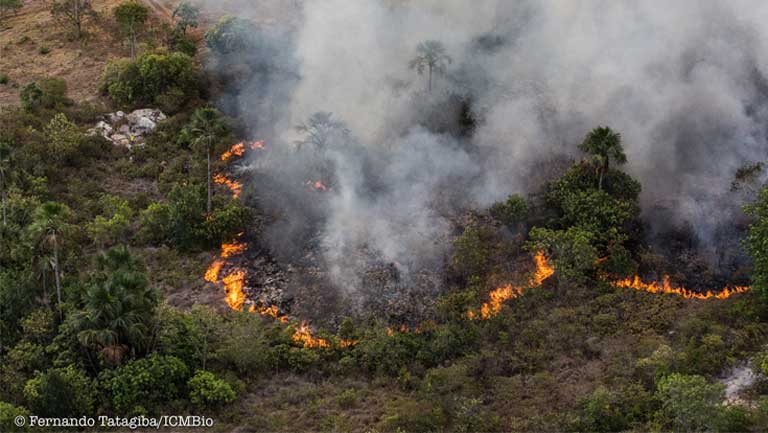- Wildfires have consumed more than a quarter of Chapada dos Veadeiros National Park, a much visited and beloved Brazilian preserve known for its biodiversity, spectacular waterfalls and ancient bedrock.
- Though 2017 has been a very dry year, authorities suspect arson, with the park’s enlargement from 65,000 to 240,000 hectares earlier this year a possible motive.
- Firefighters have now contained the blaze and the park has reopened.
- The fire destroyed at least 65,000 hectares of habitat. It will be years before the preserve’s flora and fauna recover, say experts.

The piercing cries of blue macaws could be heard rising through the forests as flames approached the birds’ nestling chicks. For 12 days, the Chapada dos Veadeiros National Park, located in the state of Goiás, endured the largest and most damaging fire in its history, in a year when record wildfires — mostly human-caused — have engulfed vast areas of the Amazon and forests in other parts of Brazil.
A team of more than 200 firefighters and logistical advisors worked day and night to contain the fire, which has destroyed at least 65,000 hectares (160,000 acres) of habitat. Highway police, Goiás state firefighters and Federal Military Police, supported by tanks and helicopters, all fought the intense blaze.
The park is one of the most important and most visited conserved areas in Brazil. A foremost tourist destination, it receives 60,000 visitors yearly. The preserve is located atop an ancient, 1.8 billion year-old plateau in Brazil’s highly biodiverse Cerrado biome. It is home to endangered and endemic species, including the pampas deer (Ozotoceros bezoarticus), maned wolf (Chrysocyon brachyurus) and jaguar (Panthera onca) — all listed as Near Threatened by the IUCN. The park boasts 350 to 400 species of vascular plants per hectare, one reason why Chapada dos Veadeiros is a UNESCO World Heritage site.
On Saturday, 28 October, rain fell on the park for the first time in a month, significantly reducing the extent of the fire, which was brought under full control the following day.

Alberto Setzer, a researcher at the government’s National Institute of Space Research (INPE), told Mongabay that the fire can partly be explained by the fact that 2017 has been a very dry year, with below average rainfall throughout September and the first three weeks of October.
“The drought however, wasn’t extreme, and we have seen similar levels in the past without the park burning down,” he said. “Drought only creates the conditions for the propagation of fire, it is humans who usually cause it.”
Park manager Fernando Tatagiba, confirmed that the wildfire was likely caused by humans. The only natural cause of fire in the Cerrado is lightning which has not struck in the region for the past month, according to Tatagiba. “We don’t know who was behind it, or whether it was intentional or not, but we do have a few suspects,” he revealed.
Some environmental activists believe the fire was set as an act of retaliation against the expansion of the park, which took place earlier this year. Chapada dos Veadeiros was increased in size from 65,000 to 240,000 hectares (160,000 acres to 600,000 acres) in June, a move which was met by fierce opposition from those who would lose their farms and homes.

The Chapada dos Veadeiros National Park was created in 1961, and then encompassed 625,000 hectares (1.5 million acres). Over decades, the reserve was reduced almost tenfold, shrinking to 65,000 hectares in 1981. This was largely a result of two factors: pressure applied by homeowners and farmers in the region who wanted to increase their share of land, and governmental infrastructure projects including the creation of a major highway.
The area destroyed by fire is coincidentally almost exactly equal to the size of the park before the 2017 expansion.
Local police are currently searching for the perpetrators.
Tatagiba said that to understand the fire’s ferocity one has to take into account that temperatures were higher than average on 17 October, winds were very strong and rainfall uncharacteristically low. In the first 24 hours of the blaze, flames consumed 7,000 hectares (17,000 acres) of forest.
Chapada dos Veadeiros is not a standalone case. Figures from INPE show that 2017 is on track to be the worst year on record for forest fires: 242,776 were detected by 30 October. More fires were seen in September of this year (110,736) than in any previous month in the 20 years that INPE has been keeping records.

It will take years to regenerate the park’s devastated wildlands. Restoration times will vary, say experts, as the reserve is composed of a mosaic of habitats, including grasslands, forests and swamps. “Some parts will take months to recuperate, others decades,” Tatagiba said. Volunteers are scouring burned over areas in search of surviving animals and endangered species.
As the fire swept through the forest, many nests and burrows were destroyed and smaller animals, including new-borns, were likely killed. Larger, faster animals made an often dangerous journey to un-burnt habitat where they could find food and shelter. Estimates of the total damage to the park’s biodiversity haven’t yet been made.
Animal lovers and tourists come from across the country, and from around the world, to spot rare animals and view the park’s breathtaking waterfalls. Chapada dos Veadeiros boasts hundreds of springs and streams that flow over some of the world’s oldest bedrock, before plummeting from the plateau’s cliffs.
The park was reopened to visitors on Wednesday, 1 November.
FEEDBACK: Use this form to send a message to the author of this post. If you want to post a public comment, you can do that at the bottom of the page.














